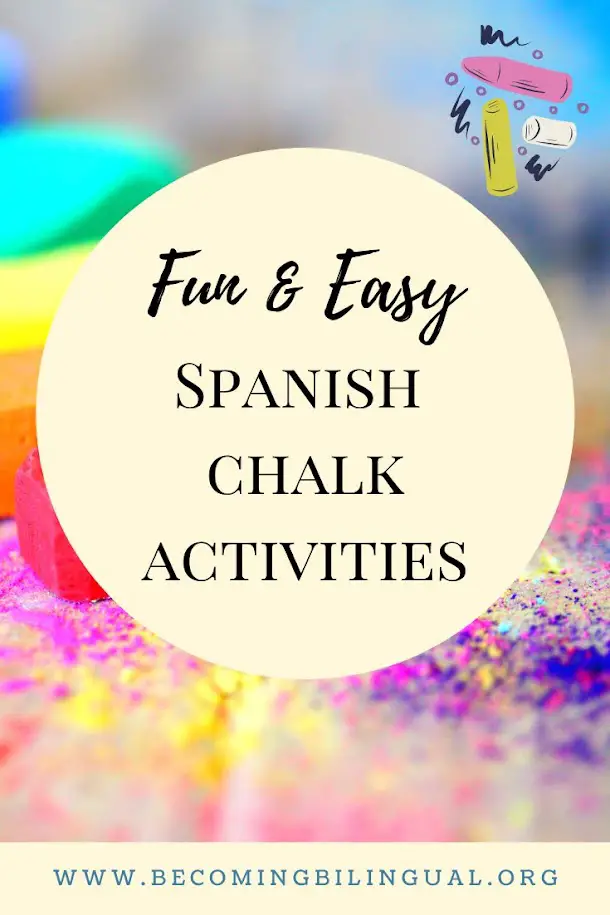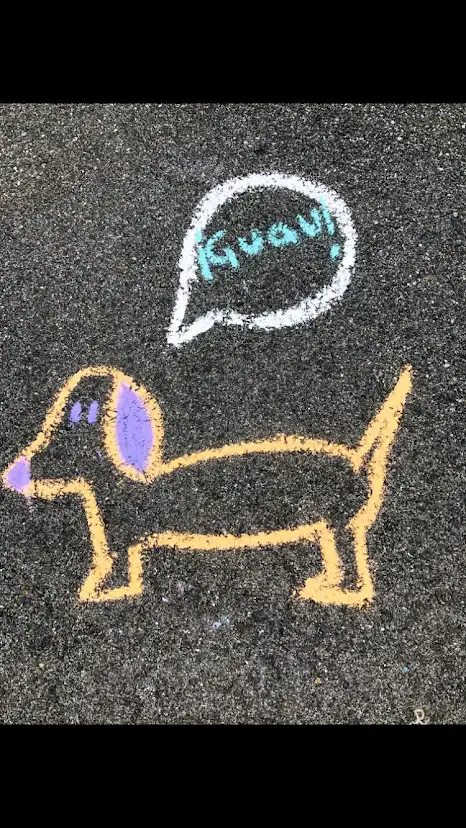Fun And Easy Chalk Activities To Learn Spanish

I’m always looking to incorporate Spanish learning into our day and that means when we’re outside, too! In the summer we try and get outside as much as possible.
One of my daughter’s favorite outside activities is playing with chalk. Without making it a chores or a learning activity, chalk can easily be used to word on Spanish language and literacy skills.
In this article I’ll talk about why it’s important to embed Spanish into your play and daily conversations, and several different ways that you can use chalk to do that!
This post contains affiliate links. If you click an affiliate link and make a purchase, I earn a small commission which supports this blog at no additional cost to you. Please see the Privacy Policy for details. Thank you for supporting me!
Table of Contents
Chalk Words and Phrases
There are many Spanish words and phrases that you may want to use when playing with chalk. Here are some of the most common ones that I use with my daughter when we’re outside playing.
la tiza (the chalk)
un pedazo de tiza (a piece of chalk)
dibujar (to draw)
escribir (to write)
añadir (to add)
¿Que estas dibujando? (What are you drawing?)
¿Vas a añadir a este dibujo? (Are you going to add to this drawing?)
¿Puedo tener la tiza azul? (Can I have the blue chalk?)
Chalk Activities In Spanish
Trace Your Body and Label It
One of my daughter’s favorite things to do with chalk is to have someone trace her. She lays on the sidewalk and I trace her outline in chalk. Then, she stands up and uses all of the colors to draw and decorate her outline. She adds fun clothes and facial expressions to the outline.
There are several ways to turn this activity into a Spanish learning experience:
One way that we do this is to talk about body parts in Spanish. I use lots of words and phrases to point out points of the body and see if my daughter can identify them or draw them onto her person. For example I might say, “donde esta la cabeza?” (Where is the head?) or “Vas a dibujar los ojos?” (Are you going to draw the eyes?.
Sometimes my daughter and I will take turns labeling different body parts, too. We’ll draw lines to different parts of the outline and practice writing the word in Spanish.
Recommended for you: Human Body Activities and Resources in Spanish
We also use my daughter’s love of decorating to work on describing clothing. As she adds different clothes and designs to her outline, we talk about them and describe them. I might say, “Vas a dibujar una falda? (Are you going to draw a skirt?) and Cual color es? (What color is it?).
Often times we trace each other several times and add details too and decorate several different people all over the sidewalk. This gives us plenty of time to work on so many Spanish words and phrases – all while we’re playing!
Scavenger Hunt
Another fun way to practice Spanish is to do a scavenger hunt and write out your list in chalk. My daughter loves to run around our front yard area and go on hunts for things. I’ll make a big list on the driveway of all of the things that she needs to find.
Usually I mix natural items (a rock, a pinecone, etc) with her outside toys (a ball, a jump rope, etc). When my daughter finds that item, she puts it next to the word on the scavenger hunt list and checks it off!
This is a lot of fun to do in different seasons as well since you can highlight different natural elements. We’ve done hunts for signs of spring, or as many different types of leaves as we can find.
Since my daughter loves scavenger hunts, we also do them inside the house all the time. Here’s another great way to use scavenger hunts to increase your kiddo’s Spanish vocabulary and reading ability: Spanish Scavenger Hunts Inside.

Hopscotch
Hopscotch is a lot of fun to draw and play and there are so many variations for how you can use this with Spanish vocabulary.
One of the most basic ways is to wrote the Spanish number words in each box. As your kiddo jumps through, they can say the names of the numbers in Spanish. I usually put the Spanish number word as opposed to the numerical number because it encourages Spanish reading and my daughter already knows her numbers.
If you have a kiddo still learning to identify their numbers, especially 1-10, you might want to put the numeral and practice naming it in Spanish.
We have also played where I will put different Spanish words in the boxes and my daughter will read them as she jumps through. I often put funny combinations for her to read (cinco, platanos, mar, etc).
Label a Picture
This is probably the most common way that my daughter and I use Spanish when we draw with chalk. My daughter loves to make pictures that tell a story or relate a game that she’s playing.
After she finishes her drawing, I encourage her to label the parts. We often start with the people and label them, then the objects that they have and the scenery.


It’s a great way for her to express herself and her stories. It also allows her to see how labels help everyone to understand her story.
Learning Spanish should be a fun activity or experience and playing with chalk is the perfect way to incorporate Spanish into your outside play! I hope this page is helpful for you on your Spanish learning journey.
Happy Learning!
Don’t forget to subscribe here and get my latest posts and resources delivered directly to your inbox!